I was interviewed by the South China Morning Post regarding Shi Huang’s theory of Maximum Genetic Diversity and the out-of-Asia theory of human evolution and dispersals. https://www.scmp.com/news/china/science/article/3292044/it-was-east-asia-chinese-scientist-challenges-out-africa-theory-human-evolution

Eurasian Back-Migration: Traces in Mythology? Berezkin Yuri Y.https://doi.org/10.31857/S0869541524030094 The author examines the world distribution of mythological motifs peculiar for Northeast Africa but absent in other parts of this continent. The corresponding narratives describe the events of the time of creation,…
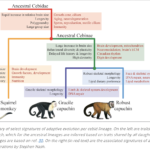
Proceedings of the National Academy of Sciences, August 22, 2022, 119 (35) e2116681119, https://doi.org/10.1073/pnas.2116681119 Signatures of adaptive evolution in platyrrhine primate genomes Byrne, Hazel , Timothy H. Webster, Sarah F. Brosnan, Jessica W. Lynch Primates of South and Central America known as platyrrhines show broad phenotypic diversity, but we…
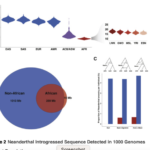
Cell 2020 Feb 20; 180(4):677-687. doi: 10.1016/j.cell.2020.01.012. Identifying and Interpreting Apparent Neanderthal Ancestry in African Individuals Lu Chen, Aaron B Wolf, Wenqing Fu, Liming Li, Joshua M Akey Admixture has played a prominent role in shaping patterns of human genomic variation,…
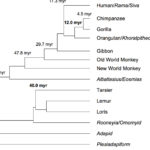
Science China Life Sciences 55 (2012): 709–25 doi:10.1007/s11427-012-4350-7 Primate phylogeny: Molecular evidence for a pongid clade excluding humans and a prosimian clade containing tarsiers Huang, Shi Interpretations of molecular data by the modern evolution theory are often sharply inconsistent with paleontological results. This…
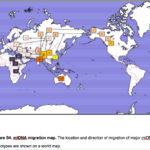
bioRxiv doi: https://doi.org/10.1101/101410 Yuan, Dejian, Xiaoyun Lei, Yuanyuan Gui, Zuobin Zhu, Dapeng Wang, Jun Yu, and Shi Huang Modern Human Origins: Multiregional Evolution of Autosomes and East Asia Origin of Y and mtDNA Recent studies have established that genetic diversities are mostly maintained…
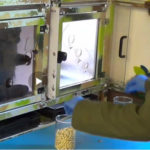
Animal Cognition (2016). doi:10.1007/s10071-016-1043-9 Intuitive probabilistic inference in capuchin monkeys Tecwyn, Emma C., Stephanie Denison, Emily J. E. Messer, and Daphna Buchsbaum The ability to reason about probabilities has ecological relevance for many species. Recent research has shown that both preverbal infants and non-human great apes can make predictions…
I reported on the current state of Nostratic theory here. A part of the review concerned a sharp critique of Allan Bomhard by George Starostin. George Starostin cited a review of Bomhard by a Soviet-Russian Uralist, Eugene Khelimskii (also spelled Helimski)….
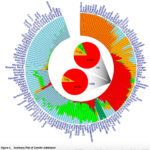
This is just a short note to reflect on the two principal ways of visualizing population genetic data: Circular and Linear. Both phylogenetic trees and admixture proportions can be visualized this way. See below some examples (I give no references…
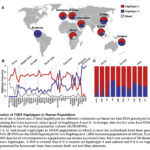
American Journal of Human Genetics 90 (2012), 809–20. doi: 10.1016/j.ajhg.2012.03.014 Genetic Adaptation of Fatty-Acid Metabolism: A Human-Specific Haplotype Increasing the Biosynthesis of Long-Chain Omega-3 and Omega-6 Fatty Acids Ameur, Adam, Stefan Enroth, Asa Johansson, Ghazal Zaboli, Wilmar Igl, Anna C.V. Johansson,…

PLoS ONE 12(1): e0169486. doi:10.1371/journal.pone.0169486 Earliest Human Presence in North America Dated to the Last Glacial Maximum: New Radiocarbon Dates from Bluefish Caves, Canada Burgeon, Lauriane, Ariane Burke, and Thomas Higham The timing of the first entry of humans into…
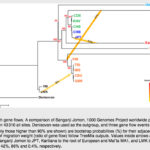
Journal of Human Genetics, advance online publication, 09/01/2016; doi: 10.1038/jhg.2016.110 A Partial Nuclear Genome of the Jomons Who Lived 3000 Years Ago in Fukushima, Japan Kanzawa-Kiriyama,Hideaki, Kirill Kryukov, Timothy A Jinam, Kazuyoshi Hosomichi, Aiko Saso, Gen Suwa, Shintaroh Ueda, Minoru Yoneda, Atsushi Tajima, Ken-ichi Shinoda, Ituro Inoue, and Naruya Saitou The Jomon period…
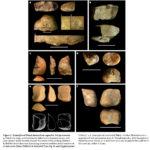
Nature 539 (2016): 85-88 doi:10.1038/nature20112 Wild monkeys flake stone tools Proffitt, Tomos, Lydia V. Luncz, Tiago Falótico, Eduardo B. Ottoni, Ignacio de la Torre, and Michael Haslam Our understanding of the emergence of technology shapes how we view the origins of…
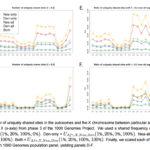
Molecular Biology and Evolution (advance publication, October 18, 2016) Signatures of archaic adaptive introgression in present-day human populations Racimo, Fernando, Davide Marnettob, and Emilia Huerta-Sánchez Comparisons of DNA from archaic and modern humans show that these groups interbred, and in…
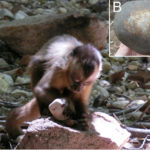
One of the contributions of this weblog to our evolutionary thinking is the call for a more holistic, bi-hemispheric approach to hominid and human origins and, consequently, an increased appreciation of New World monkey behaviors as a surprisingly close parallel…
Journal of Indo-European Studies 43, nos. 3-4 (2015): 348-56. “Response to Kassian et al., ‘Proto-Indo-European-Uralic comparison from the probabilistic point of view’.” Ringe, Don. Link Rarely does a response to a paper become a must-read, when the paper itself deserves only a passing look….

In-between the sensible exchanges on the out-of-America hypothesis with genome blogger, Max Lushington, I read a fascinating piece of Russian web scholarship. George Starostin, the son of a famed Russian linguist, Sergei Starostin, and an accomplished long-range linguist in his own…
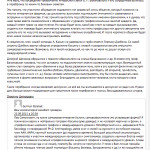
Political and epistemological battles between a group of Russian official, or academic scientists and a group of Russian entrepreneurial, or folk scholars continue. Since the publication of a “resolution” denouncing Anatole Klyosov’s DNA Genealogy as pseudoscience (extensively covered on this…
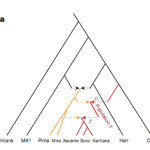
Science DOI: 10.1126/science.aab3884 Genomic evidence for the Pleistocene and recent population history of Native Americans Raghavan, Maanasa, Matthias Steinrücken, Kelley Harris, Stephan Schiffels, Simon Rasmussen, Michael DeGiorgio, Anders Albrechtsen, …Eske Willerslev. How and when the Americas were populated remains contentious….
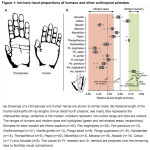
Nature Communications 6, no. 7717 (2015) doi:10.1038/ncomms8717 The Evolution of Human and Ape Hand Proportions Almecija, Sergio, Jeroen B. Smaers, and William L. Jungers. Human hands are distinguished from apes by possessing longer thumbs relative to fingers. However, this simple…
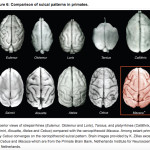
Nature Communications 6 (2015), no. 7580 doi:10.1038/ncomms8580 Cerebral complexity preceded enlarged brain size and reduced olfactory bulbs in Old World monkeys Gonzalez, Lauren A., Brenda R. Benefit, Monte L. McCrossin, and Fred Spoor. Analysis of the only complete early cercopithecoid…

A street fight is raging on (here and here) in the Russian academe between scientists and pseudoscientists. It’s increasingly difficult to tease apart the former from the latter. It’s all one bloody mess. It appears the most recent comments of an independent observer such as…
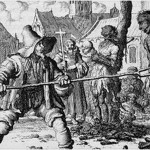
Apologies to my English-only readership. This post is in Russian and represents my responses to an ongoing web war between academic and entrepreneurial scientists in Russia. A large, multidisciplinary group of prominent Russian academics headed by geneticist Elena Balanovsky published a…

Every now and then I introduce the English-only readers of this blog to notable developments in human origins research taking place among Russian academics. I previously aspects of Yuri Berezkin‘s comparative mythology project, Vladimir Napol’skikh‘s peculiar linguistic opinions and surprising…
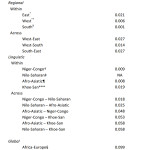
Nature (2014) doi:10.1038/nature13997 The African Genome Variation Project Shapes Medical Genetics in Africa Gurdasani, Deepti, Tommy Carstensen, Fasil Tekola-Ayele, Luca Pagani, Ioanna Tachmazidou, Konstantinos Hatzikotoula, Savita Karthikeyan, Louise Iles, Martin O. Pollard, Ananyo Choudhury, Graham R. S. Ritchie, Yali Xue, Jennifer Asimit, Rebecca N. Nsubuga, Elizabeth H. Young, Cristina Pomilla, Katja Kivinen, Kirk…
Cultural Developments in the Eurasian Paleolithic and the Origin of Anatomically Modern Humans: Proceedings of the International Symposium “Cultural Developments in the Eurasian Paleolithic and the Origin of Anatomically Modern Humans” (July 1–7, 2014, Denisova Cave, Altai), edited by А.P. Derevianko, М.V. Shunkov. Pp. 165-171. Novosibirsk: Publishing…
I recently returned from the American Anthropological Association Meetings in Washington DC where I presented a paper on kinship, enjoyed the company of other members of the interdisciplinary “Kinship Circle” group led by Dwight Read and Fadwa El-Guindi, socialized with my…
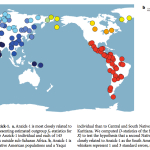
World Archaeology 46, no. 5 (2014): 752-774. DOI: 10.1080/00438243.2014.966273 Solutrean Hypothesis: Genetics, the Mammoth in the Room Stephen Oppenheimer, Bruce Bradley, and Dennis Stanford. Abstract The Solutrean hypothesis for the origin of the Clovis archaeological culture contends that people came from…
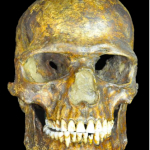
Science DOI: 10.1126/science.aaa0114 Genomic Structure in Europeans Dating Back at Least 36,200 Years Andaine Seguin-Orlando, Thorfinn S. Korneliussen, Martin Sikora, Anna-Sapfo Malaspinas, Andrea Manica, Ida Moltke, Anders Albrechtsen, Amy Ko, Ashot Margaryan, Vyacheslav Moiseyev, Ted Goebel, Michael Westaway, David Lambert,…
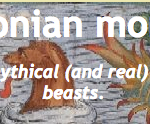
1. Patagonian Monsters. A new website run by Argentina-based Austin Whittall is a wealth of sharp analyses of human genetic variation from an intellectual point of view that’s close to out-of-America II. Whittall is critical of the mainstream interpretations of human…
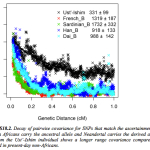
Nature 514, 445–449 (23 October 2014) doi:10.1038/nature13810 Genome sequence of a 45,000-year-old modern human from western Siberia Qiaomei Fu, Heng Li, Priya Moorjani, Flora Jay, Sergey M. Slepchenko, Aleksei A. Bondarev, Philip L. F. Johnson, Ayinuer Aximu-Petri, Kay Prufer, Cesare de Filippo,…
I’ve been monitoring global web responses to Raghavan et al.’s “Upper Palaeolithic Siberian Genome Reveals Dual Ancestry of Native Americans” that appear in the comments sections on Dienekes, Gene Expression and Eurogenes sites. The Web Gem Reward of this week goes…
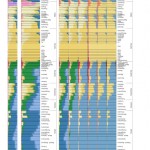
Courtesy Alexander Kim, the long-awaited paper by the Eske Willerslev team became finally available to me. This is obviously not the last word on the subject of Amerindian origins, and the David Reich Lab has a different interpretation of ancient…
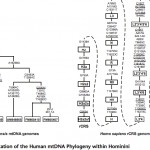
In one of my comments on Anthrogenica.com, I mistakenly denied that Behar et al. (2012) reported the two mutations A2758G and G7146A shared between late European Neandertals and the modern human L2’3’4’5’6 clade. As a reminder, A2758G and G7146A were highlighted in…
I spent the last few days posting at a forum called Anthrogenica.com debating “archaic admixture” in mtDNA and Y-DNA, answering questions regarding viable alternatives to out-of-Africa and observing the online behaviors of “science bloggers.” As always, my counterarguments against the out-of-Africa theory…
Over at Anthrogenica, I’ve been having some heated (as always) but this time also productive discussions regarding the interpretation of currently available genetic evidence. In the following I will sketch out a hypothesis that increasingly makes sense to me. 1….
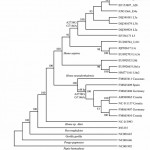
Russian Journal of Genetics, September 2013, Vol. 49, No. 9, 975-978 Mitochondrial DNA Polymorphisms Shared Between Modern Humans and Neanderthals: Adaptive Convergence or Evidence for Interspecific Hybridization Malyarchuk, Boris A. Abstract An analysis of the variability of the nucleotide sequences in the…
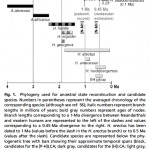
Proceedings of the National Academy of Sciences, October 21, 2013 doi:10.1073/pnas.1302653110 No Known Hominin Species Matches the Expected Dental Morphology of the Last Common Ancestor of Neanderthals and Modern Humans Gómez-Roblesa, Aida, José María Bermúdez de Castroc, Juan-Luis Arsuaga, Eudald Carbonelle, and P. David…
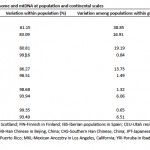
Gisele Horvat has kindly pointed me to this new pre-print. This post is cross-posted at www.kinshipstudies.org. Global patterns of sex-biased migrations in humans Chuan-Chao Wang, Li Jin, Hui Li. Abstract A series of studies have revealed the among-population components of…
In his recent presentation on correlations between genes and myths in Eurasia and North America (see video in Russian, from 53:50 on), Vladimir Napol’skikh expressed a strong opinion on Amerindian linguistic diversity and several proposals of genealogical kinship between Amerindian…
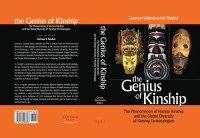
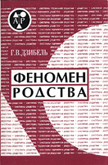
Recent Comments